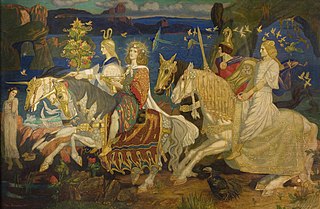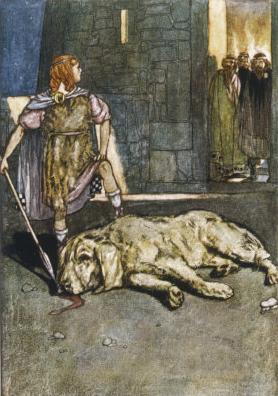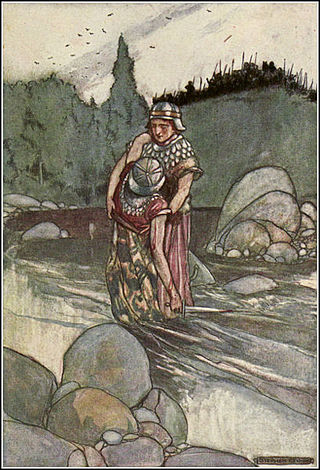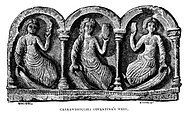
Imbolc or Imbolg, also called Saint Brigid's Day, is a Gaelic traditional festival. It marks the beginning of spring, and for Christians, it is the feast day of Saint Brigid, Ireland's patroness saint. Its traditional date is 1 February, about halfway between the winter solstice and the spring equinox. Historically, its traditions were widely observed throughout Ireland, Scotland and the Isle of Man. Imbolc is one of the four Gaelic seasonal festivals, along with: Beltane, Lughnasadh and Samhain.

Irish mythology is the body of myths indigenous to the island of Ireland. It was originally passed down orally in the prehistoric era. In the early medieval era, myths were written down by Christian scribes, who Christianized them to some extent. Irish mythology is the best-preserved branch of Celtic mythology.

Lugh or Lug is a figure in Irish mythology. A member of the Tuatha Dé Danann, a group of supernatural beings, Lugh is portrayed as a warrior, a king, a master craftsman and a saviour. He is associated with skill and mastery in multiple disciplines, including the arts. Lugh also has associations with oaths, truth, and the law, and therefore with rightful kingship. Lugh is linked with the harvest festival of Lughnasadh, which bears his name. His most common epithets are Lámfada and Samildánach. This has sometimes been anglicised as "Lew of the Long Hand".

The Morrígan or Mórrígan, also known as Morrígu, is a figure from Irish mythology. The name is Mór-ríoghan in modern Irish before the spelling reform, and it has been translated as "great queen" or "phantom queen".

In Irish mythology, the Badb, or in modern Irish Badhbh —also meaning "crow"—is a war goddess who takes the form of a crow, and is thus sometimes known as Badb Catha. She is known to cause fear and confusion among soldiers to move the tide of battle to her favoured side. Badb may also appear prior to a battle to foreshadow the extent of the carnage to come, or to predict the death of a notable person. She would sometimes do this through wailing cries, leading to comparisons with the bean-sídhe (banshee).
Cú Roí mac Dáire is a king of Munster in the Ulster Cycle of Irish mythology. He is usually portrayed as a warrior with superhuman abilities and a master of disguise possessed of magical powers. His name probably means "hound of the plain/field", or more specifically, "hound of the battlefield". He is the son of Dáire mac Dedad, and thus belongs to the Clanna Dedad. However, T. F. O'Rahilly believed this to be artificial, stating that "Cú Roí and Dáire are ultimately one and the same".

Cú Chulainn, is an Irish warrior hero and demigod in the Ulster Cycle of Irish mythology, as well as in Scottish and Manx folklore. He is believed to be an incarnation of the Irish god Lugh, who is also his father. His mother is the mortal Deichtine, sister of King Conchobar mac Nessa.

Ferdiad, son of Damán, son of Dáire, of the Fir Domnann, is a warrior of Connacht in the Ulster Cycle of Irish mythology. In the Táin Bó Cúailnge, Ferdiad finds himself on the side of the war opposite to that taken by his best friend and foster-brother Cú Chulainn, with whom he had trained in arms under the renowned warrior woman Scáthach. He and Cú Chulainn are equal in all martial feats, with two exceptions: the Gáe Bulg, a barbed spear which Scáthach has taught only Cú Chulainn to use; and Ferdiad's horn skin, which no weapon can pierce.

Fergus mac Róich/Róigh is an Irish hero and a character in the Ulster Cycle of Irish mythology. Formerly the king of Ulster, he is tricked out of the kingship and betrayed by Conchobar mac Nessa, becomes the ally and lover of Conchobar's enemy, queen Medb of Connacht, and joins her expedition against Ulster in the Táin Bó Cúailnge. Fergus is described as being of huge size and sexual potency. This leads him into many a precarious situation as in the story of the Táin Bó Flidhais.

Táin Bó Cúailnge, commonly known as The Táin or less commonly as The Cattle Raid of Cooley, is an epic from Irish mythology. It is often called "the Irish Iliad", although like most other early Irish literature, the Táin is written in prosimetrum, i.e. prose with periodic additions of verse composed by the characters. The Táin tells of a war against Ulster by Queen Medb of Connacht and her husband King Ailill, who intend to steal the stud bull Donn Cuailnge. Due to a curse upon the king and warriors of Ulster, the invaders are opposed only by the young demigod, Cú Chulainn.

The Ulster Cycle, formerly known as the Red Branch Cycle, is a body of medieval Irish heroic legends and sagas of the Ulaid. It is set far in the past, in what is now eastern Ulster and northern Leinster, particularly counties Armagh, Down and Louth. It focuses on the mythical Ulster king Conchobar mac Nessa and his court at Emain Macha, the hero Cú Chulainn, and their conflict with the Connachta and queen Medb. The longest and most important tale is the epic Táin Bó Cúailnge. The Ulster Cycle is one of the four 'cycles' of Irish mythology and legend, along with the Mythological Cycle, the Fianna Cycle and the Kings' Cycle.
Imbas forosnai, is a gift of clairvoyance or visionary ability practised by the gifted poets of ancient Ireland.
Celtchar, son of Uthechar or Uthidir, is a character from the Ulster Cycle of Irish Mythology. In Scéla Mucce Maic Dathó he is described as "a grey, tall, very terrible hero of Ulster". When he challenges Cet mac Mágach for the champion's portion, Cet counters that he once emasculated Celtchar with a spear at Celtchar's own house. He lives in Dún Lethglaise, also known as the Mound of Down, or Rathkeltair in Downpatrick, County Down. His wife is Findmór of Dún Sobairche. He wields a spear or lance, the Lúin Cheltchair, whose lust for blood is so great it has to be dipped in a cauldron of poison to control it.
Dáire mac Fiachna is an Ulster cattle-lord who appears in the Ulster Cycle of Irish mythology as the owner of Donn Cuailnge over which the Táin Bó Cuailnge is fought. Following the medieval Irish genealogies, Dáire mac Fiachna appears to have been a paternal relative of Conchobar Mac Nessa. He appears in the Táin Bó Regamon within a ghastly chariot alongside the Morrígan. He is described as a great man wrapped in a red cloak with a forked staff of hazel at his back. The Morrígan first introduces him as h-Uar-gaeth-sceo-luachair-sceo, before later revealing that he is Dáire mac Fiachna, and the owner of Donn Cuailnge.
In the Ulster Cycle of Irish mythology, Dubthach Dóeltenga was a cynical ally of Fergus mac Róich who rarely had a good word to say about anyone. He accompanied Fergus to escort Deirdre and Naoise back to Ireland under the orders of Conchobar and later followed Fergus into exile in Connacht following Naoise's murder under Conchobar's orders. He was responsible for the death of Conchobar's son, among others. He later fought beside him in the Táin Bó Cuailnge, although at one point Fergus kicked him right out of the camp for his plans to kill Cú Chulainn.

The Cooley Peninsula is a hilly peninsula in the north of County Louth on the east coast of Ireland; the peninsula includes the small town of Carlingford, the port of Greenore and the village of Omeath.
Fedelm is a female prophet and fili, or learned poet, in the Ulster Cycle of Irish mythology. She appears in the great epic Táin Bó Cuailnge, in which she foretells the armies of Medb and Ailill mac Máta will face against the Ulaid and their greatest champion, Cú Chulainn. A prophetess of the same name appears in another tale, which associates her with Cú Chulainn.
Ann Dooley is a professor emerita with the Centre for Medieval Studies and the Celtic Studies Program at St. Michael's College at the University of Toronto where she specializes in Irish literature. She has published a translation of Acallam na Senórach entitled Tales of the Elders of Ireland as well as a study of Táin Bó Cuailnge entitled Playing the Hero: Reading the Irish Saga Táin Bó Cuailnge.
Amergin mac Eccit is a poet and warrior in the court of Conchobar mac Nessa in the Ulster Cycle of Irish mythology. He was the son of Eccet Salach, a smith, and grew to the age of fourteen without speaking or washing himself. One day Athirne, the Ulaid's chief poet, sent his servant to Eccet to order an axe. The servant was shocked when Amergin uttered a precocious, cryptic poem, and ran home to tell his master what he had heard.
Edmund Crosby Quiggin was a British linguist and scholar. Born in Cheadle, Staffordshire, he was educated at Kingswood School in Bath. In 1893 he matriculated at Gonville and Caius College, Cambridge, to read Modern and Medieval Languages. He graduated with first-class honours. The fellows of Caius included the lawyer and legal historian Charles Henry Monro, who spoke Irish and encouraged Quiggin to study in this area.










